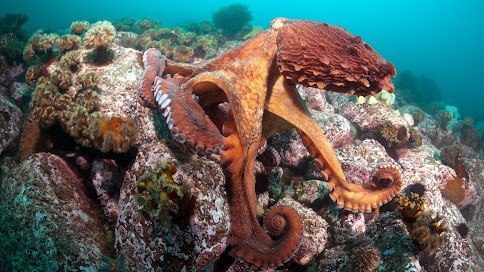Octopus
Octopus, plural octopuses, or octopi, in general, any eight-armed cephalopod (octopod) mollusk of the order Octopoda. The true octopuses are members of the genus Octopus, a large group of widely distributed shallow-water cephalopods.
Octopuses vary greatly in size: the smallest, O. arborescent, is about 5 cm (2 inches) long, while the largest species may grow to 5.4 meters (18 feet) in length and have an arm span of almost 9 meters (30 feet). The typical octopus has a saccular body: the head is only slightly demarcated from the body and has large, complex eyes and eight contractile arms. Each arm bears two rows of fleshy suckers that are capable of great holding power. The arms are joined at their bases by a web of tissue known as the skirt, at the center of which lies the mouth. The latter organ has a pair of sharp, horny beaks and a file-like organ, the radula, for drilling shells and rasping away flesh.
The octopus takes water into its mantle and expels the water after respiration through a short funnel or siphon. Most octopuses move by crawling along the bottom with their arms and suckers, though when alarmed they may shoot swiftly backward by ejecting a jet of water from the siphon. When endangered they eject an inky substance, which is used as a screen; the substance produced by some species paralyzes the sensory organs of the attacker.
The best-known octopus is the common octopus, O. Vulgaris, a medium-sized animal that is widely distributed in tropical and temperate seas throughout the world. It lives in holes or crevices along the rocky bottom and is secretive and retiring by nature. It feeds mainly on crabs and other crustaceans. This species is thought to be the most intelligent of all invertebrate animals. O. Vulgaris has highly developed pigment-bearing cells and can change its skin colors to an astonishing degree with great rapidity. Each pigment-bearing cell (chromatophore) is individually innervated from the brain.
The veined octopus (Amphioctopus marginatus) is also known for its intelligence. In 2009 biologists reported having observed the animals excavating coconut half-shells from the ocean floor and carrying them for use as portable shelters. Such behavior is regarded by biologists as the first documented example of tool use by an invertebrate.
Octopuses have separate sexes, and the male has a specially modified arm, called a hectocotylus, by means of which it inserts spermatophores, or packets of sperm, directly into the female’s mantle cavity. O. Vulgaris mates during the winter, and the eggs, about 0.3 cm (1/8 inch) long, are laid under rocks or in holes, the total number of eggs amounting to more than 100,000. During the four to eight weeks required for the larvae to hatch, the female guards the eggs, cleaning them with her suckers and agitating them with water. Upon hatching, the tiny octopods, which closely resemble their parents, spend several weeks drifting in the plankton before taking refuge on the bottom.
Octopuses feed mainly upon crabs and lobsters, although some are plankton feeders, and they are fed upon by a number of marine fishes. They have long been considered a culinary delicacy by peoples of the Mediterranean, East Asia, and other parts of the world.
"Curiosity and wonder drive us to explore, and that curiosity has led me and some keen buddies to explore one of the last relatively unknown regions of the planet - the pelagic ocean. The image here is of a rarely encountered pelagic squid, a denizen of the dark waters away from sunlight."
Words & image by Paul Caiger




Comments
Post a Comment